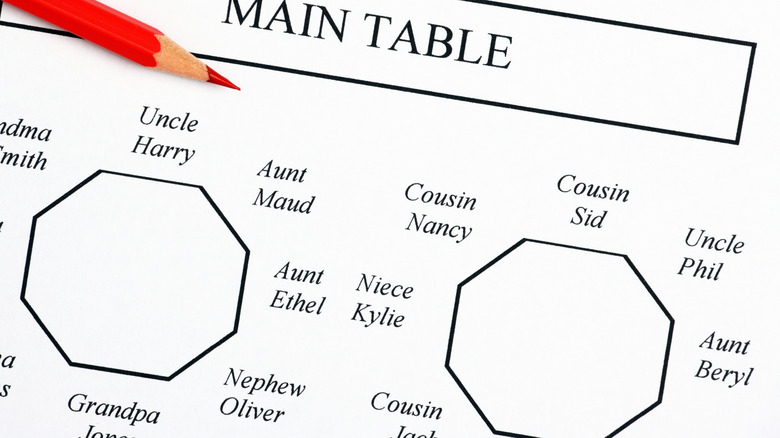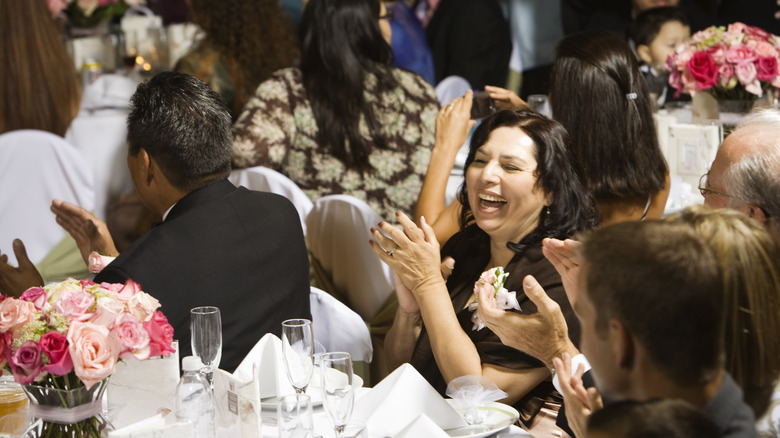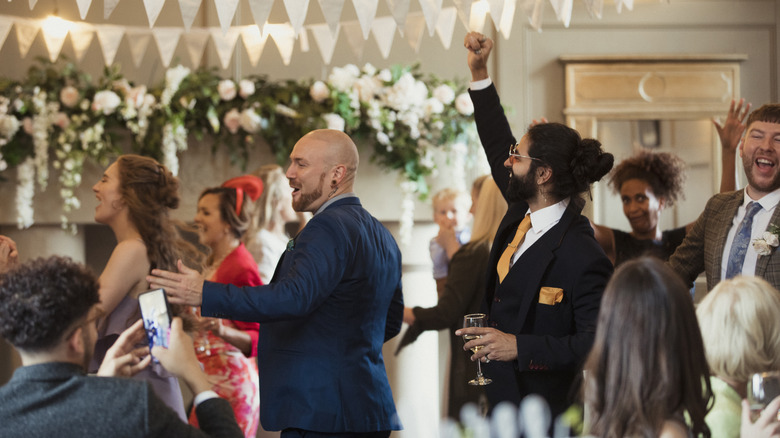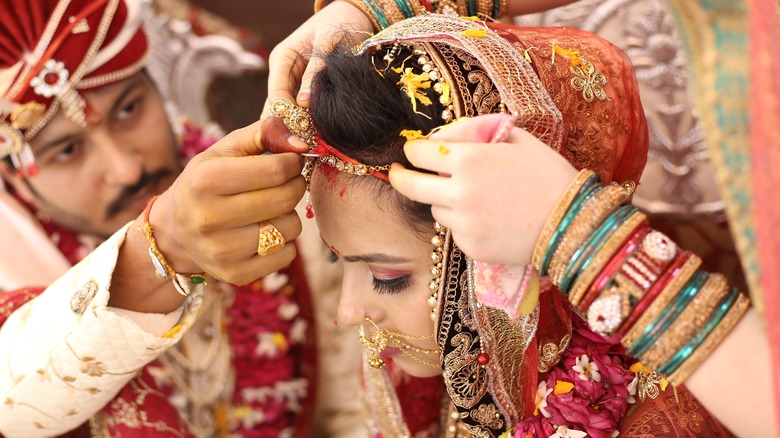The Mistakes You Don't Want To Make With Your Wedding Seating Chart
Although weddings are supposed to be magical events about love and happily-ever-after, planning them can be a feat. Even if you're not a type-A bridezilla who needs to have everything just-so — these tips can help prevent you from becoming one — trying to orchestra a day you'll remember forever can take a toll.
And, unfortunately, even if you hire a wedding planner, you still have to do the seating chart on your own. Of course, a planner can guide you in your choices — you are paying them a pretty penny after all — but because they don't know the wedding guests intimately or any possible drama involved, it's something you and your partner have to do whether later in the planning process or earlier on to jumpstart your wedding planning. "I always tell people if they're having any kind of a dinner party, just draw out a table chart, laminate it, get some stickies, and try to do girl-boy-girl-boy, because it's more interesting that way," Vogue's Director of Special Projects Sylvana Ward Durrett tells Vogue. "Never seat spouses next to each other. The whole point of these things is to meet new people, and to be interested in what others are doing."
While you may not be creating the seating chart for the Met Gala, as Durrett does every year, or worrying about whether Timothée Chalamet will behave at Anna Wintour's table, this doesn't mean you can't pretend you are. So, grab some markers and stickies, and go for it. Just be sure not to make the mistakes others have accidentally made.
Forgoing a seating chart
Unless you're planning to elope, going without a seating chart can create a nightmare situation. It may seem easy to bunch your friends and family on one side of the room and your partner's friends and family on the other, but this means you're not taking specific factors into consideration, and a wedding is an occasion where it's pertinent to do so.
While it's nice to assume everyone will be on their best behavior, if there's any tension between guests, things can go awry once the champagne starts flowing. Suddenly, you have Aunt Suzie confronting Uncle Billy about a 10-year-old argument. Sure, this is an extreme case, but we've all seen those weddings on the news or social media where a handful of guests are arrested — sometimes even the bride and groom!
And to think all of this could be avoided with some colorful stickies and a laminated chart.
Having a singles table
Society has already decided that single people have something 'wrong' with them, so why would you want to add to that stigma? You want all your guests, no matter their relationship status, to feel welcome and not like social outcasts. "Nix the idea of a 'singles' table," wedding planner Ashley Thompson tells The Knot. "You may have been playing matchmaker behind the scenes to see if you could set your old co-worker [up] with your cousin, but this may embarrass your guests or make them feel uncomfortable. Instead, you can sprinkle the singles in with their married or couple friends to give them a sense of comfort."
Singles don't want to be at a singles table just as much as your 16-year-old cousin doesn't want to be seated at the children's table with a bunch of first-graders. It may be your big day, but considering the feelings of those who have come to celebrate with you both near and far should be at the top of your list.
Waiting for everyone to RSVP
You should know by now that no matter the RSVP date on the invitation, not everyone will pay attention to it. In some cases, brides and grooms are put in situations where they're still chasing people down to RSVP just a few days before the wedding, while, in other cases, guests bail at the last minute or are no-shows. Unfortunately, while your wedding is a priority for you, this isn't necessarily the case for your guests. This is why you should absolutely not wait to start your seating arrangement for the wedding reception.
"Initially one would do a floor plan with the estimated maximum guests based on the invited list and expected attendees up to six months out once the venue is decided," wedding planner Philip Carr tells Vogue Australia. "Look at it again a few weeks before when all the replies are in. From there, there is continual updating as some guests cancel last minute and seating arrangements get moved around."
Of course, some people will promptly respond yes and others will decline right away, so this is a good place to start. Then, fill in the rest of the spots and arrange later. Just make sure the seating chart is locked down within 72 hours of the wedding, especially if you're having a seated dinner where it's essential to know each guest's meal preference.
Failing to consider the kid situation
First and foremost, it's important to know you're under zero obligation to invite kids to your wedding. Not only are weddings expensive, but kids, especially younger ones, can be unpredictable and cause mayhem. Will not inviting your guests' kids lead to some sort of backlash? It could because everyone thinks their kids are perfect — especially those who don't discipline their little darlings as they should. Is this your problem, though? No.
"It's your wedding, therefore it's your guest list, so the decision is ultimately up to you," etiquette expert Lisa Mirza Grotts tells Newsweek. "Make the invitation clear, avoid saying no kids welcome. Simply make the form of address to the people who are invited only. Make sure when you address the invitations you are crystal clear so there is no confusion."
Should you decide to include children, consider their ages. Kids eight years old and under need some form of supervision, so seat them next to their parents. Kids over age eight up to age 13 or 14 are good to mix together at a kids' table. Anyone older than this, though, should be seated with their families.
Not asking for your parents' input
Since, traditionally, the parents of the bride pay for the wedding, it only makes sense to get their input regarding the planning process; however, this is no longer the norm. While the groom's or the bride's side may not be footing the entire bill, a 2022 survey from The Knot found that couples' parents typically contribute about 51% to the overall wedding budget, with couples picking up the rest. But, even if your parents are only pitching in 15%, they deserve some say regarding seating arrangements — especially since they may be aware of family beef you never knew existed.
Not only can your parents offer the inside scoop on who should be seated far away from each other, but getting their input also gives them a chance to say where they'd prefer to sit. If you're not having a head table for the wedding party, your parents are going to want prime seating real estate and to be surrounded by people they genuinely know and like — as well as an unobstructed view of you and your partner — so give that to them. There's nothing worse than a grumpy father of the bride on your wedding day.
Getting overzealous with table guests
Unless your wedding is going to consist of long rectangular farm tables that seat 25 people on each side, you want to stick to tables of eight to 10 people — and with ample room between each guest. No one wants to be on top of each other, especially if they're strangers, so don't try to pile as many people as possible at any one table.
"Whether your friend brought a surprise plus-one or your great aunt simply never sent in her RSVP, having extra room at your tables can be a serious lifesaver," event planner Alison Laesser-Keck tells Martha Stewart Weddings. "Seating eight people at tables that could accommodate [10] will give your guests some more elbow room, while making it easier to add that last-minute place setting."
If you find it impossible to accommodate everyone you'd like to seat at a specific table, break up the table into two groups and seat guests at adjacent tables. Besides, people will move around after dinner once the celebration is underway. Don't drive yourself mad just because your besties from college are spread out over two tables instead of all being seated at one. You'll get over it, and so will they.
Ignoring the layout of the space
Not matter where you get married, you need to consider every part of the venue's space. Where will the band or DJ be situated? How many windows does the space have? How large is the dance floor? These types of questions should guide you in your decision making process.
For example, maybe you have an aunt who thinks every room is drafty, so you shouldn't put her near a window. Seniors may not want to be as close to the speakers and dance floor as the younger people, so make sure you arrange this accordingly. Is your favorite co-worker claustrophobic and needs to see the door at all times to be comfortable? Then take this into consideration, too.
Granted, your wedding reception is only going to last a few hours, but if you're aware of the quirks, likes, and dislikes of your guests, you'd be remiss not to honor those if you can.
Overthinking it
Ultimately, your wedding day is going to be a fantastic and memorable occasion as long as you take a deep breath and realize it will not be without a glitch or two — but remember that glitches make for great stories! The best you can do when creating your seating chart is being flexible and open to input from others without losing the vision of your dream wedding day. "Be careful how much you listen to other people take on their individual concerns," event planner Holly Poulter tells SheerLuxe. "Especially when it comes to extended families or warring ex-partners. Be amenable and considerate, to an extent, but if you find yourself bending over backwards for a handful of difficult people, you're not outside your rights to lay down the law."
If you're lucky enough, this will be your only wedding (some wedding planners can actually tell whether a marriage will last), so let yourself enjoy it. At the end of the day, you can only control so much, so give yourself a break and don't overthink it.








